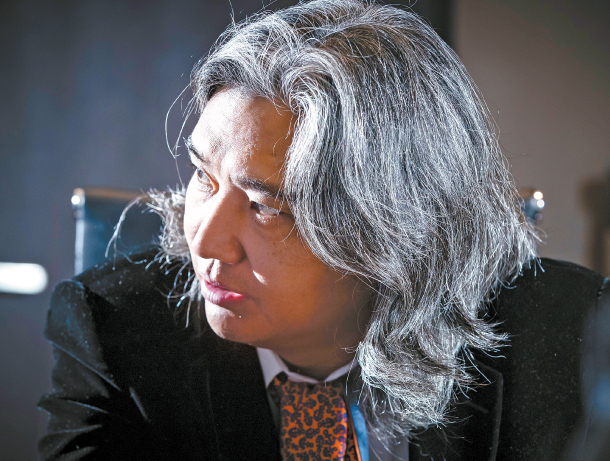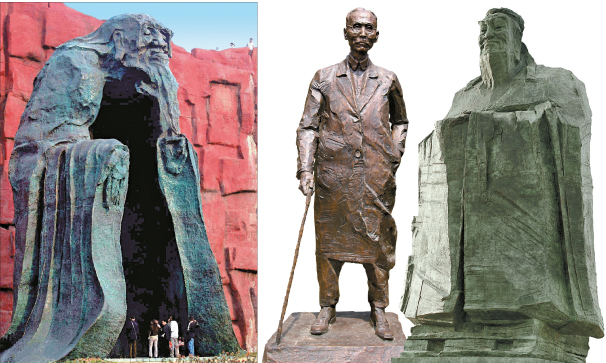Sculptor captures the spirit of historical figures: Wu Weishan curated works by Chinese greats for exhibition

Artist Wu Weishan talks about the exhibit “A Dialogue with Qi Baishi,” which he curated for the Seoul Arts Center. [KWON HYUK-JAE]

Sculptures of Chinese philosopher Laozi, left, Korean independent activist An Chang-ho, middle, and Confucius, right, made by artist Wu Weishan. [JOONGANG ILBO]

A sculpture of Chinese artist Qi Baishi by artist Wu Weishan. [JOONGANG ILBO]
The JoongAng Ilbo met with Wu on the opening day of “A Dialogue with Qi Baishi,” an ongoing Seoul Arts Center exhibition curated by the sculptor to talk about his work and the exhibit, which includes pieces by several great Chinese artists.
The following are edited excerpts from the interview.
Q. You curated the exhibition yourself. Please tell us about it.
A. It’s a place where people can take a peek at China’s efforts to revolutionize its arts. It’s about contradicting tradition while trying to preserve it at the same time - it’s chasing, and even surpassing, what’s from the past. I was curious how [art works] from great Chinese artists would be displayed in Korea, so I immediately visited the museum right after I arrived. The space was amazing. It is as if all the works were alive.
The exhibition’s subhead is “Between Likeness and Unlikeness.” What does that mean?
It’s a saying by Qi Baishi. When a drawing is too similar to its subject, it’s flattering, and when it’s too different from that subject, it feels like a trick. Qi once said, “Those who learn from me live, but those who resemble me die.” Imitation is the start of every creation, but when it stops there, it fails to become a true piece of art.
Your book about your theories and sculptures has also been published in Korean. How did that come about?
Prof. Park Jong-yeon of Inje University, who has been a friend of mine for 14 years, translated the book, while well-known book designer Chung Byeong-gyu produced it. It’s as if my works have come to Korea for marriage. [The Korean version] is way better than the Chinese one in terms of structure. I’m very surprised and thankful [for the work].
You have concentrated on making statues of famous figures for the past 20 years. Why is that?
There are around 500 of them in total. They are usually elder artists, scholars and literati. There’s a saying that goes, “A writing is a bowl for tao (the way).” Tao is a kind of zeitgeist. An outstanding scholar or theorist represents the spirit of the age. That person becomes not only art himself, but also the history.
What is your favorite piece among your own sculptures?
I like all my works. Each one has special connections and backgrounds. But if I really had to choose, I would pick the sculptures of Confucius and Laozi. As the great fathers of Chinese philosophy, they spread their beliefs and values and [shaped Chinese history.] Of course, we do not have their real portraits. I had to [visualize their inner beings.] For Confucius, I emphasized his gentle and wise image, while for Laozi, I depicted a more natural being - someone who resembles the water and the sky. One of my favorite works is “Laozi - Unity of Heaven and Man,” which is located in Jiangsu, northern Shanghai. It is an 18-meter (59-foot) tall statue, and the center of the sculpture has an empty space. It reflects the Taoist belief that “existence” comes from “non-existence.”
Your works also include Korean independence activists An Chang-ho and Seo Jae-pil, right?
Yes, I created them in 2009 and they are located in the Sculpture Park at Inje University to celebrate Korea’s liberation movement [against its colonization by imperial Japan, 1910-1945]. I’ve also made sculptures of doctor Jang Gi-ryeo - a philanthropist who helped poor people - and war hero Park Tae-jun. I’m also planning to make sculptures of activists An Jung-geun and Kim Gu [by this year] to celebrate the 100th anniversary of the March 1 movement and the foundation of the Provisional Government of the Republic of Korea (1919-48), as well as that of the May Fourth Movement in China. They proved that justice existed in history - and it will survive forever.
Why haven’t you made any sculptures of famous businessmen?
I agree that many businessmen have contributed to [improving] society. But you need to look at history in the long term. For instance, if you look at a huge building in Seoul from far away, it looks very small. You never know if someone great will continue to be great in 10 or 100 years. Making sculptures for people like CEO of Alibaba Group Jack Ma is a task for future sculptors.
You are both a public officer and an artist - has there ever been a conflict between the two?
Everyone is given the same 24 hours in a day. There was some conflict. But what is art? Art is about understanding humanity and delivering what’s considered universal values. I have come to understand humanity and society by meeting with a lot of artists in my country and making art-related policies.
What have you achieved as a public officer?
I made sculpture a mandatory course in every elementary, middle and high school. Also, there are so many students who don’t even know how to use a brush. Calligraphy is not simply a writing style - it’s the root of Asian art. All my sculptures are based on calligraphy. Now, around 200 colleges in China have calligraphy majors.
What do you have to say to those who are worried about China’s cultural hegemony?
Culture does not belong to anyone. [Each culture] has to accept what’s good about other cultures. You don’t need to worry. Just because a Chinese person is learning English doesn’t mean that they are suddenly American. We must share what’s considered global heritage. Just as Qi thought, the end of every culture is peace.
BY PARK JUNG-HO [yeo.yerim@joongang.co.kr]










with the Korea JoongAng Daily
To write comments, please log in to one of the accounts.
Standards Board Policy (0/250자)